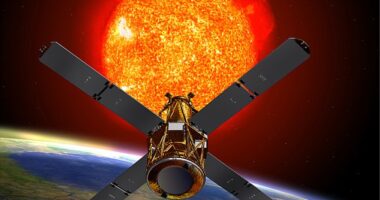A GEOMAGNETIC storm is expected to hit Earth’s magnetic field tomorrow – here’s what you need to know.
A massive solar flare erupted from the Sun last Friday, and now experts predict a geomagnetic storm will follow.
A solar fare is an eruption of intense high-energy radiation from the sun’s surface.
When this energy hit Earth’s magnetic field, they are called ‘solar storms’.
While Friday’s solar flare did not impact Earth, it did send “some dense solar wind plasma in our direction”, according to SpaceWeather.com.
Now NOAA experts say that these winds will culminate in a G1-class geomagnetic storm.


Geomagnetic storms are defined as “a major disturbance of Earth’s magnetosphere that occurs when there is a very efficient exchange of energy from the solar wind into the space environment surrounding Earth,” per NOAA.
“These storms result from variations in the solar wind that produces major changes in the currents, plasmas, and fields in Earth’s magnetosphere.”
G1 geomagnetic storms, specifically, don’t harm humans on Earth but can cause minor disruptions to power grids and satellite operations.
This particular storm will also produce stunning auroral displays that may be visible across the Northern Hemisphere.
Most read in Tech
Coronal Holes
Scientists noted that the solar winds powering this geomagnetic storm are flowing from a “cyclops-like hole in the sun’s atmosphere”.
Holes in the sun’s atmosphere are known as ‘coronal holes’.
They consist of areas in the Sun’s atmosphere that appear dark in X-ray and ultraviolet images.
Coronal holes comprise a hot and glowing outer layer of atmosphere that surrounds the sun and can extend for millions of miles into space
What can a geomagnetic storm do?
Geomagnetic storms are graded by severity on the G-Scale from G1 to G5, with the latter being the most powerful.
A G1 classification is considered weak and can result in minor degradation of high-frequency radio communication and occasional loss of radio contact.
Meanwhile, a G5 storm – which is quite rare – is considered ‘extreme’ and can be very powerful.
It can cause a radio blackout on the entire sunlit side of the Earth lasting for a number of hours.
NOAA experts explained further: “Low-frequency navigation signals used by maritime and general aviation systems experience outages on the sunlit side of the Earth for many hours, causing a loss in positioning.”
“Increased satellite navigation errors in positioning for several hours on the sunlit side of Earth, which may spread into the night side.”










